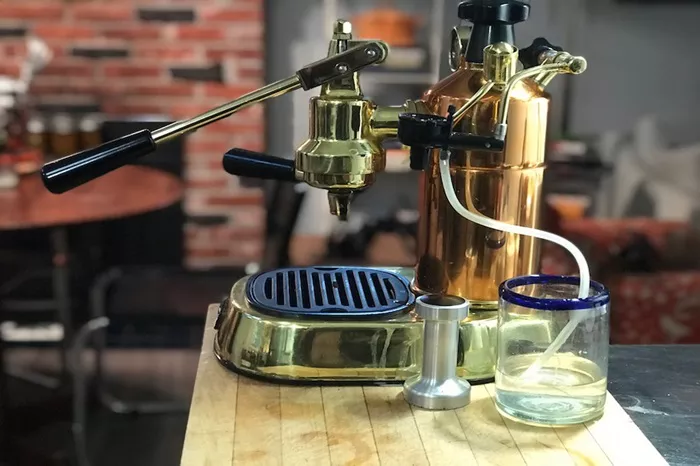A manual espresso machine is a type of coffee maker that uses a lever mechanism to brew espresso. Unlike automatic or semi-automatic machines, manual machines require the user to generate the pressure needed to extract the coffee. This is done by physically pulling a lever, which pushes water through the coffee grounds.
The key difference is control. With a manual machine, you control every step of the brewing process—from how much pressure you apply to how long you brew. This level of involvement is what makes manual espresso machines a favorite among passionate coffee enthusiasts.
How It Works
Manual espresso machines are straightforward in design but require attention and practice to use well. Here’s how they typically work:
Pre-Infusion: After tamping your coffee grounds into the portafilter, you begin by slowly raising or lowering the lever. This introduces a small amount of water into the coffee puck, allowing it to bloom and settle evenly.
Pressure Generation: The real action starts when you push the lever down (or, in some machines, release it). This motion creates the pressure—usually around 9 bars—needed to force hot water through the compacted coffee grounds.
Water Flow Control: You decide how long to maintain pressure and how fast or slow to release the lever. This affects the final taste of your espresso.
Every element—from grind size to tamp pressure to the timing of the lever—affects the flavor. That’s why manual machines are often seen as tools for those who want to craft their coffee like an art.
Types of Manual Espresso Machines
There are two main types of manual espresso machines: spring piston machines and direct lever machines. Each has its own feel and level of control.
Spring Piston Machines
These machines have a spring mechanism that helps regulate the pressure during extraction. When you pull down the lever, you compress the spring. Once released, the spring pushes the piston, applying consistent pressure.
Pros
- More consistent pressure
- Easier for beginners
Cons
Less control over pressure variations during extraction
Direct Lever Machines
These require you to manually generate and maintain pressure throughout the shot. You pull the lever and control the pressure from start to finish.
Pros
- Maximum control over extraction
- Great for experimenting with flavor profiles
Cons
- Steeper learning curve
- Inconsistent results until you build skill
Advantages
Using a manual espresso machine has several perks:
Full Control
You decide everything—pre-infusion time, pressure, temperature (depending on the model), and brew time. This allows for fine-tuned customization.
Flavor Customization
Once you understand how each variable affects taste, you can dial in your shot to highlight certain notes—whether it’s fruity acidity or deep chocolate richness.
Craftsmanship and Satisfaction
There’s something deeply satisfying about pulling a perfect shot with your own hands. It’s a skill to be proud of and an experience you feel connected to every time.
Durable Build
Most manual machines are made with metal and designed to last for decades with proper maintenance. They’re often more mechanically simple than electric models, meaning fewer parts can break.
Disadvantages
Of course, manual machines aren’t for everyone.
Skill Required
It takes time to learn how to use a manual espresso machine well. There’s a lot of trial and error.
Inconsistency
Until you gain experience, results can vary from one shot to the next. Small changes in your pressure or grind size can lead to big flavor differences.
Time and Effort
Making espresso manually is not fast. From heating the machine to dialing in your shot, it takes more time than using an automatic machine.
Comparison with Other Machines
Manual vs. Semi-Automatic Machines
Semi-automatic machines automate water pressure. You still grind, tamp, and time your shot, but a pump provides consistent pressure.
Manual Pros
- More control over pressure
- More satisfying for enthusiasts
Semi-Auto Pros
- Easier to use
- More consistent for beginners
Manual vs. Fully Automatic Machines
Fully automatic machines handle everything—grinding, dosing, tamping, and brewing. You press a button and get coffee.
Manual Pros
- Full control
- Better flavor potential if mastered
Fully Auto Pros
- Convenience
- Fast and consistent results
Who It’s Best For
Manual espresso machines are perfect for:
- Coffee Lovers who want to learn and grow their skills.
- Hobbyists who enjoy the ritual of making coffee.
- Purists who value flavor above all else.
- Tinkerers who like experimenting with technique.
They are not ideal for:
- People short on time
- Those new to espresso who want quick, reliable results
- Anyone who prefers convenience over involvement
Popular Models
Here are some well-known manual espresso machines worth checking out:
Flair Espresso Pro 2
A modern, portable manual machine. Great for beginners and travel. Offers high pressure and solid build quality.
La Pavoni Europiccola
A classic Italian lever machine that’s been around since the 1960s. Beautiful design and solid performance.
Cafelat Robot
A unique manual machine with a retro look. It’s compact and doesn’t require electricity. Known for pulling excellent shots once dialed in.
Elektra Micro Casa Leva
A visually stunning spring piston machine. Very consistent and beautifully made in Italy.
Olympia Cremina
Swiss-made direct lever machine known for its exceptional build quality and longevity. Expensive, but considered a lifetime investment.
Conclusion
A manual espresso machine is more than just a coffee maker—it’s a tool for exploration, a canvas for creativity, and a tribute to tradition. While they demand time and effort, the reward is a deeper connection with your coffee and the satisfaction of mastering a timeless craft.
If you’re someone who finds joy in process and precision, a manual espresso machine might be the perfect addition to your coffee journey. It’s not about speed—it’s about the experience, the control, and the reward of a shot well pulled.
Related topics:
- Bulletproof Cold Brew: A Detailed Guide to the Perfect Brew
- Black Cold Brew Coffee: A Refreshing and Bold Choice
- Brown Sugar Cream Cold Brew: A Sweet and Smooth Coffee Delight


